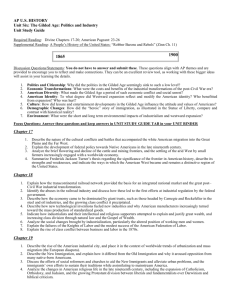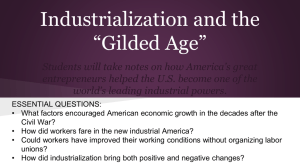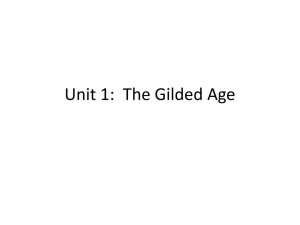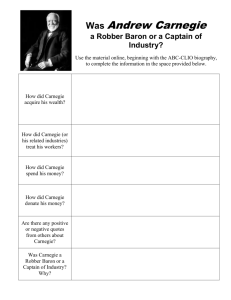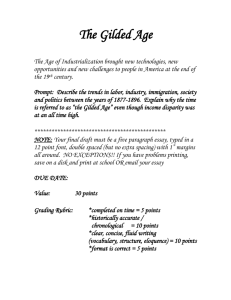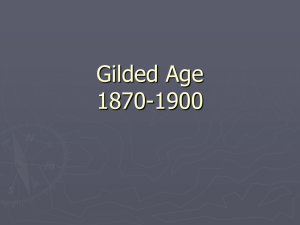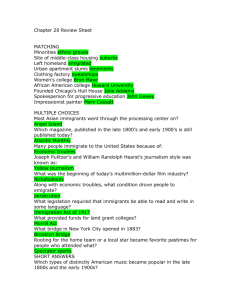The Gilded Age & Industrial Era Unit Exam
advertisement
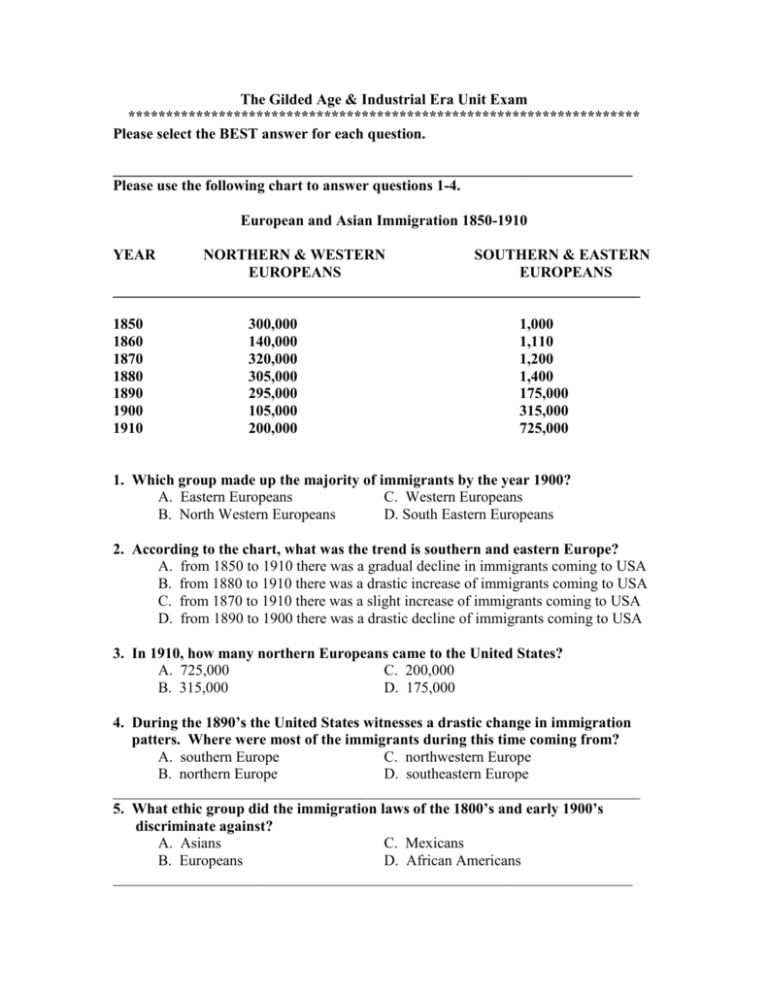
The Gilded Age & Industrial Era Unit Exam ******************************************************************** Please select the BEST answer for each question. _____________________________________________________________________ Please use the following chart to answer questions 1-4. European and Asian Immigration 1850-1910 YEAR NORTHERN & WESTERN SOUTHERN & EASTERN EUROPEANS EUROPEANS ______________________________________________________________________ 1850 1860 1870 1880 1890 1900 1910 300,000 140,000 320,000 305,000 295,000 105,000 200,000 1,000 1,110 1,200 1,400 175,000 315,000 725,000 1. Which group made up the majority of immigrants by the year 1900? A. Eastern Europeans C. Western Europeans B. North Western Europeans D. South Eastern Europeans 2. According to the chart, what was the trend is southern and eastern Europe? A. from 1850 to 1910 there was a gradual decline in immigrants coming to USA B. from 1880 to 1910 there was a drastic increase of immigrants coming to USA C. from 1870 to 1910 there was a slight increase of immigrants coming to USA D. from 1890 to 1900 there was a drastic decline of immigrants coming to USA 3. In 1910, how many northern Europeans came to the United States? A. 725,000 C. 200,000 B. 315,000 D. 175,000 4. During the 1890’s the United States witnesses a drastic change in immigration patters. Where were most of the immigrants during this time coming from? A. southern Europe C. northwestern Europe B. northern Europe D. southeastern Europe ______________________________________________________________________ 5. What ethic group did the immigration laws of the 1800’s and early 1900’s discriminate against? A. Asians C. Mexicans B. Europeans D. African Americans _____________________________________________________________________ ________________________________________________________________________ 6. Why was the Pendleton Civil Service Act passed? A. to force money to be backed by silver instead of gold B. to regulate unfair railroad practices C. to end the spoils system D. to eliminate European and Asian immigration _______________________________________________________________________ 7. The settlement houses during the late 1800’s offered solutions to poor city dwellers through: A. protection from the power of political machines B. social services C. provided a basic income D. protection from area crime ______________________________________________________________________ 8. Nativists main objective during the Gilded Age was to: A. restrict immigration C. offer social services to immigrants B. allow immigration D. help teach immigrants to assimilate ______________________________________________________________________ 9. During the late 1800’s the United States rapidly became an urban nation. One reason for the transformation was: A. Many farm workers had not started joining and organizing unions B. Farm life became extinct C. Immigrants were unwilling to do farm labor D. Farm machinery and factory production caused the necessity of farm labor to decrease ______________________________________________________________________ 10. During the late 1800’s political machines gained tremendous power in the political arena. What was one reason for this? A. They did not accept graft as part of their income B. They demanded many needed political reforms C. They provided jobs and assistance to many immigrants D. They were honest and attracted support _______________________________________________________________________ 11. Lynching can BEST be described as: A. Seizing property illegally B. Being seized by a mob and executed C. Being imprisoned without having a fair trial D. Denied the right to an attorney ________________________________________________________________________ _______________________________________________________________________ 12. In 1896, the Supreme Court of the United States heard and ruled on Plessy v. Ferguson. This case stated: A. All public universities had to admit women and minorities to receive any federal money B. All schools that were segregated were violating federal law and would be Punished C. Public schools had to integrate their transportation systems D. established the “separate but equal” doctrine _______________________________________________________________________ 13. Women during this period were: A. Rejecting traditional roles B. Making their way into professional jobs, such as education C. Fighting for suffragist rights and fighting immorality D. All of the above ______________________________________________________________________ Please examine the chart and answer question 14 and 15. Estimated Rural and Urban Population In the United States YEAR 1860 1870 1880 1890 1900 1910 1920 (numbers in thousands) RURAL POPULATION 25,227 28,656 36,026 40,841 45,835 49,973 51,553 URBAN POPULATION 6,217 9,902 14,130 22,106 30,160 41,999 54,158 Source: United States Census Bureau 14. What is the difference in the amount of people living in urban areas in 1860 and 1920? A. 47,941 C. 47,841,000 B. 48,941 D. 48,941,000 15. What time period had the highest change in urban population? A. 1900-1910 C. 1880-1890 B. 1910-1920 D. 1890-1900 ________________________________________________________________________ _______________________________________________________________________ 16. The ability to read and write is called: A. Assimilation C. Yellow Journalism B. Accommodation D. Literacy _______________________________________________________________________ Jim Crow Poll Tax Assimilation Literacy Lynching Grandfather Clause 17. What ethnic group was affected during the Gilded Age by the terms listed above? A. Chinese Americans C. African Americans B. European Americans D. All of the above _______________________________________________________________________ 18. In 1882 an act was aimed at a particular community that worked below the minimum wage, thus angering unions who were pursuing higher pay. What was this act called? A. Japanese Exclusion Act C. African American Exclusion Act B. Chinese Exclusion Act D. Philippine Exclusion Act _______________________________________________________________________ 19. Which city became known as the “golden door” for the number of immigrants that entered this port? A. San Francisco C. Baltimore B. Philadelphia D. New York _______________________________________________________________________ 20. American industrial growth of the late 1800’s was made possible by: A. the household economy C. technological advances B. government reforms D. the development of labor unions ______________________________________________________________________ 21. During the Industrial Revolution critics called the powerful industrialist: A. Anarchist C. Captains of the Industry B. Robber Barons D. Philanthropists ______________________________________________________________________ 22. American communication was revolutionized in the late 1800’s by: A. the steam engine C. telegraph & telephone B. workable light filament D. refrigeration & sewing machines _______________________________________________________________________ _______________________________________________________________________ 23. How did industrial growth affect the distribution of wealth? A. wealth was concentrated in the hands of a few industrialist B. all Americans enjoyed a high standard of living C. the income gap between the rich and poor became smaller D. the income gap between farmers and factory workers widened _____________________________________________________________________ 24. Members that joined the American Federation of Labor were: A. women, children, farm and factory workers B. railway and construction workers C. African American workers D. only skilled workers ____________________________________________________________________ 25. The Sherman Anti-Trust Act was established to: A. encourage strikes against business owners B. promote fair industrial competition C. encourage the growth of monopolies D. place higher taxes on business profits ____________________________________________________________________ 26. Laissez-faire is a French word that means “to let do.” How did laissez-faire politics relate to business principles during the Industrial Revolution and Gilded Age? A. the government made no policies to regulate business principles B. labor union membership was outlawed C. the government was allowed to implement legislation on businesses as it pleased D. employees could join as many labor unions as they liked ____________________________________________________________________ 27. The Pendleton Civil Service Act was passed to: A. end Asian immigration to the United States B. place additional regulations on railroads C. end hiring practices based on the spoils system D. change the way money was backed from gold to silver _____________________________________________________________________ 28. The American dream of “rags to riches” was illustrated in the works of: A. John Steinbeck’s novel The Grapes of Wrath B. Mark Twain’s novel The Gilded Age C. Upton Sinclair’s novel The Jungle D. Frederick Jackson Turner’s The Turner Thesis ______________________________________________________________________ ______________________________________________________________________ 29. American industry impacted culture by ALL of the following ways EXCEPT: A. the gross domestic product decreased B. railroad transportation improved C. numerous advances were made in communication D. electric power caused businesses to grow _______________________________________________________________________ Read the following passage and answer questions 30-32. Andrew Carnegie was born in Scotland in 1835. He experienced the Industrial revolution in Europe and knew how industrialization had a very harsh side. His father was a skilled weaver who lost his job due to the invention of the power loom. Carnegie’s family faced many hard times and in 1848 they immigrated to the United States. Carnegie started working at the age of 13 in a cotton mill for $1.20 a week. By the age of 18 he was the Post Secretary to the Superintendent in the Pennsylvania Railroad Company. During the Civil War, he boss took a job in the US War Department and Carnegie was promoted. By 30 years of age he was earning over $500,000 a year. It did not take Carnegie long before was controlling the American steel industry. Carnegie preached the Gospel of Wealth. In other words, he felt that people should be free to make as much money as they possibly can and then they should give it away; back to their community. Carnegie donated over $350 million dollars to libraries, artist, research, institutes, etc. He also set up an institute to study how to abolish war. 30. Based upon this reading, Carnegie can BEST be described as: A. a Social Darwinist C. a philanthropist B. a prohibitionist D. a robber baron 31. The Gospel of Wealth promotes: A. developing monopolies B. Social Darwinism C. government regulation of businesses D. citizenship 32. Andrew Carnegie was: A. a Captain of the Industry B. a Robber Baron C. born very wealthy D. the head of the US War Department ________________________________________________________________________ ________________________________________________________________________ Read the following quote and answer question 33. “It will be a great mistake for the community to shoot the millionaires, for they are the worker bees that make the most honey, and contribute the most to the hive even after they have gorged themselves.” Andrew Carnegie 33. Carnegie statement is saying that he is: A. a robber baron C. a Captain of the Industry B. Social Darwinist D. Prohibitionist _______________________________________________________________________ 34. Which of the following statements DID NOT cause the growth of big business? A. small firms started merging form large companies B. the government favored laissez-faire politics C. the nation had a rich supply of natural resources D. the development of new inventions made businesses more efficient ________________________________________________________________________ 35. Which statement DOES NOT describe the effects of the Industrial Revolution in the United States? A. labor unions grew C. monopolies formed B. people lived in harsh conditions D. the workforce decreased ________________________________________________________________________ 36. What do child labor, railroad strikes, socialism and the rise of labor unions ALL have in common? A. they were effects of the Industrial Revolution B. they were encouraged by the US government during the Industrial Revolution C. many employers or factory owners were involved in or associated with them D. they were al causes of the Industrial Revolution ________________________________________________________________________ 37. The Knights of Labor was a union composed of: A. unskilled workers but no blacks could join B. skilled workers of any race C. unskilled workers, women, children and blacks could join D. skilled workers, only whites and males _______________________________________________________________________ Located in Midwest Farmers Money backed by Silver 3rd Party Presidential Candidate 38. What association can be linked to the above list? A. Knights of Labor C. Robber Barons B. American Federation of Labor D. Populist ________________________________________________________________________ ________________________________________________________________________ Andrew Carnegie J.P. Morgan Cornelius Vanderbilt John D. Rockefeller 39. Which description DOES NOT relate to the above list? A. they all supported the populist Party B. They controlled America’s industries C. were called Captains of the Industry D. each stimulated economic growth _______________________________________________________________________ 40. This organization pushed the United States government to pass an 8-hour workday, equal pay and to abolish child labor. This group was the: A. Anarchist C. American Federation of Labor B. Knights of Labor D Workers of the World ______________________________________________________________________ 41. What did the Pullman Strike and the Homestead Strike have in common? A. the general public sympathized with the factory owners B. employers promoted union membership C. violence occurred after wages were cut and talks failed D. they were a result of the Haymarket Riot. _____________________________________________________________________ Read the following passage and answer question 42. On May 4th, 1886 someone threw a bomb into the crowd. The bomb landed in a police formation and killed 7 officers. Violence erupted when gunfire was exchanged between the crowd and the police. Dozens of people were killed. The investigators never found the person responsible for throwing the bomb. 8 members of an Anarchist Party were tried for conspiracy to commit murder resulting in 4 men being hung. 3 of those tried committed suicide while in jail and one was pardoned. Many felt the conviction was based on public outrage and not evidence. 42. What event is being described? A. Pullman Strike C. Los Angeles Riot B. Homestead Strike D. Haymarket Riot _______________________________________________________________________ 43. Graft, corruption and scandal were terms MOST associated with: A. political machines C. the Gilded Age B. only Grant’s Presidency D. the Spoils System _______________________________________________________________________ _______________________________________________________________________ 44. Which political party controlled politics through MOST of the Gilded Age? A. Anarchist C. Democrats B. Republicans D. Populist _______________________________________________________________________ 45. All of the following are true statements about the Interstate Commerce Commission EXCEPT: A. they outlawed a number of questionable practices B. they stopped large companies receiving low rates C. pooling and rebates were stopped D. farmers and railroad shippers opposed this act _______________________________________________________________________ 46. This scandal plundered the city treasury for over $75 million to $200 million before members were arrested. Many private companies were involved and kickbacks were common. What scandal is being described? A. Belknap Scandal C. Indian Post Scandal B. Credit Mobilier D. Tweed Ring ______________________________________________________________________ 47. This pioneer was a doctor of the poor. She is remembered for her studies of the Hull House. She also lobbied for better education and sanitation. This social worker is: A. Mary Baker Eddy C. Elizabeth Cady Stanton B. Jane Addams D. Myra Blackwell ______________________________________________________________________ 48. Which US President was involved with scandal after scandal during the Gilded Age? A. Ulysses S. Grant C. James Garfield B. Benjamin Harrison D. Grover Cleveland ______________________________________________________________________ 49. The assassination of ____________ led to the passage of the Pendleton Act. A. Ulysses S. Grant C. William McKinley B. Benjamin Harrison D. Grover Cleveland _____________________________________________________________________ 50. Which industrial leader founded Standard Oil and controlled 90% of all oil refineries in the United States? A.. Vanderbilt C. Carnegie C. Rockefeller D. Morgan ____________________________________________________________________ ____________________________________________________________________ 51. Patronage or the “spoils system” is when: A. the government stays out of business practices B. office holders reward their supporters with federal jobs C. industrial leaders share their fortune with those less fortunate D. prospective employees must pass a series of examinations before hiring ____________________________________________________________________ 52. Which economic theory was based on “survival of the fittest?” A. Social Darwinism C. Gospel of Wealth B. Assimilation Laws D. Laissez-faire ____________________________________________________________________ 53. Which inventions caused the development of time zones? A. streetcars C. trolleys B. railroads D. steamships ____________________________________________________________________ 54. Which inventor is responsible for the assembly line being used in the United States? A. Henry Ford C. Thomas Edison B. Samuel Morse D. J.P. Morgan ___________________________________________________________________ 55. All of the following statements are true about Populist EXCEPT: A. they opposed large corporations because it threatened individual opportunity B. they favored backing money with silver instead of gold. C. they started the GRANGE Movement D In 1892 their candidate was elected President __________________________________________________________________ Examine MAP A and answer questions 56-57. 56. Populist supporters were located in ALL of the following areas EXCEPT: A. areas that were highly industrialized B. the Midwest C. agrarian areas D. in a majority of the states 57. What area of the United States LEAST supported the Populist Movement: A. western states C. northwestern states B. southern states D. northeastern states ______________________________________________________________________ _____________________________________________________________________ Examine Map B and answer 58-59. 58. What area of the United States prohibited women’s suffrage prior to 1920? A. western states C. northern states B. southern states D. eastern states 59. Upon examining Map B, which of the following statements in NOT true? A. the 19th Amendment had no impact o the United States B. western states pioneered women suffrage C. some areas granted suffrage to women prior to 19th Amendment D. all southern states opposed women’s suffrage ____________________________________________________________________ ESSAY During the Gilded Age unrest was common. Examine the list below and explain what caused the event and what was the result of the event. Great Railroad Strike of 1877 Haymarket Riot of 1886 Homestead Strike of 1892 Pullman Strike of 1894. Gilded Age Exam Key 1. 2. 3. 4. 5. 6. 7. 8. 9. 10. 11. 12. 13. 14. 15. 16. 17. 18. 19. 20. 21. 22. 23. 24. 25. 26. 27. 28. 29. 30. 31. 32. 33. 34. 35. 36. 37. 38. B B C D A C B A D C B D D A A D C B D C B C A D B A C B A C D A C B D A C D 39. 40. 41. 42. 43. 44. 45. 46. 47. 48. 49. 50. 51. 52. 53. 54. 55. 56. 57. 58. 59. A D C D C B D D B A C C B A B A D A D D D
